M/Cing to SA: Machu Picchu Full Report
We explore the Sacred Valley
The Sacred Valley stretches roughly from Cusco on the east to Machu Picchu on the western tip. The Urubamba river rushes down its center, careening over rocks and anything else in its way. It is one of the fiercest rivers I’ve ever seen. Along side the Urubamba — and I mean feet not yards away — runs the narrow gauge train track that brings the two essentials the Valley now needs –tourists and food/supplies. The tracks are busy at all hours of day and night (when they’re not washed out of course, which happens frequently) bringing the aforementioned resources. The train is the primary way of moving through the valley, unless you count trekking, horse, cows, and the occasional tractor. The road stops about half way between Cusco and MP at a place called Ollantaytambo. If you’re going to MP, there’s only two choices: board the train at Ollantaytambo or start walking.
The mountains that jut up from the river aren’t just tall, they’re incredibly steep and jagged, Most days we’ve been here you can’t see the tops as they disappear into the clouds. To get to MP, trekkers have to go up and over them numerous times among the more than 100 Incan trails discovered around Machu Picchu. Treks to MP take anywhere from five to 14 days and they’re not for the soft of foot. There is a constant stream of young trekkers flooding into Ollantaytambo either on their way in or out. Trekking to MP is a young man –and woman’s — endeavor.
Even in February, which is considered the low season with rain nearly every day, the colors of the place almost overwhelm one’s eyes. The red-mud color of the Urubamba, the lush, dark green of the mountains, the brown of the rocks/mud that form walls and and buildings, the flowers that seem to grow everywhere, all surround and play in the fields that grow every imaginable crop you can think of from corn to onions to rice. Add to this the bright, bright, BRIGHT colors of the traditional clothes people wear on a daily basis and the Sacred Valley is a continuous feast for the eyes.
The heart of the Incan empire was located in the Valley. From Cusco the Inca’s ruled most of South America during their peak time (1250-1550). Today it’s a beautiful city where Incan art and culture can be seen and studied. None of the palaces– or any other Incan building for that matter– are standing now as the Spanish and earthquakes destroyed them all. Yet, the Incan ruins remain a prominent part of the city as many, many colonial building are built on top of Incan foundations. It’s pretty apparent as the stone work during the Incan time was at a level difficult to fathom. Huge stones, cut and placed together so precisely that no mortar was needed. Stone after huge stone after huge stone. There are large sections of Cusco that have mulltiple “styles” of stonework on top of each other representing different builders over the centuries.
At the other end of the valley lies Machu Picchu, high up in the jagged mountains. No one knows what MP was (a fortress, a monstary, a resort for Incan emperors?) how it was built (it’s huge, beautiful and is made of thousands of huge rocks), who lived there beyond royals and workers. The Incan’s had no written language and the Spanish either never found it or if they did, didn’t describe it in any of their writings. Yet there are a century’s worth of speculation on all things MP. Hiram Bingham, a Yale scholar and archiaologist, “rediscovered” Machu Picchu in 1911 and led its formal uncovering (it had been lieing dormant under jungle growth for centuries). He’s a controversial figure who is both admired and despised by Peruvians. HB literally founded what would become the single biggest tourist attraction in South America. His efforts led to its discovery by the rest of the world. On the other hand, he took more than 10,000 items back with him to Yale. Only this year have Yale and the Peruvian government come to an agreement to bring most of the artifacts back to Peru in time for Machu Picchu’s 100th anniversary of its rediscovery in June.
I can’t really explain the lure that Machu Picchu has had on me, but for as long as I can remember it’s been the No. 1 place I’ve wanted to visit. It was my unstated target destination when KR and I bought the 4WD Sportsmobile to wander South America in 2003 (only to end upside down on an East Texas interstate). Every time one of its iconic pictures appeared on any magazine, I’d quickly buy it and then go to KR and say, “We got to go!” Many of you reading this have been the recipient of one of my schemes to get you to accompany me to MP. So, it was quite weird to be sitting on the Inca Rail train last weekend riding toward my dream destination. It didn’t matter that it was lightly raining, that there were sure to be hundreds of people with us, that we weren’t on the Hiram Bingham train, nor that we weren’t staying at the famous hotel at MP’s entrance. None of that mattered because somehow, someway, we were going to Machu Picchu this day!
Here is the simple fact of our visit to Machu Picchu: none of the hundreds of perfectly-shot photos I’ve seen of the site will ever do it justice. No written description will ever describe or explain it. It is simply stunning. My own hypothesis why neither film nor word will ever do it justice is because they are at best two-dimensional and the place is three-dimensional. Machu Picchu is at the top of one knife-edge peak surrounded by other peaks as far as you can see. The clouds, mist, and cliffs all take your breadth away. Then, right in the center of all of this, stands Machu Picchu, carved into and around one of these peaks. It’s much larger than I expected and our guide said there were rooms for 1000’s of workers. How do you explain an assault on one’s senses? I can’t. So, I leave you with this one simple, but very serious thought:
Go to Machu Picchu. Any time of the year will do. Get there any way you can. You’ don’t have to be a vagabond and roam around. Just take a week and go see it. Do it. There is nothing in the world like it.
The Logistics of Getting There
It’s taken twenty years of dreaming, two years of planning, and 60 days of motorcycle riding to arrive at the Valley’s doorstep. The logistics of getting from Cusco to Machu Picchu seemed complicated, especially given our high level of pre-planning (not), but we were given a basic road map on how best to do it by Jorge Hernandez from Iquique. Here then is Fred’s Everything You Need to Know Guide on how to do Machu Picchu. Print this and save it for your trip. You’ll thank me later.
- Step One – Figure out your general game plan: First, when should you go? I’m told that June-July is the best time with the least rain. Yet, February was suppose to be horrible and it was terrific and there were even a couple of days of sunshine. Go when you can schedule it and expect to use a pancho. The starting point for everything is Cusco, so you’ll have to get there anyway you can. It’s fairly high up so all the advice about hanging in Cusco for a couple of days to get use to the altitude is true. Plus Cusco is a great place to explore. We decided to ride NV to Ollantaytambo from Cusco on Saturday afternoon, stay overnight and catch the 6:30AM Sunday train to MP the next morning. We left NV at the hotel. We caught the 2:00PM train back to Ollantaytambo and were having dinner after a nap by 7:00PM. Great day.
- Step Two- Train Tickets: We purchased train tickets from Ollantaytambo (not Cusco) to Machu Picchu at the Inca Rail office in Cusco. Cost about $100 each round-trip. Two things of import here: Ollantaytambo was suppose to be a great place to spend some time (m0re on this later) and we decided to take the Inca Rail line versus the Peru Line for two reasons: (1) It was a lot cheaper. The famous Hiram Bingham train car is operated by Peru Lines and was hundreds of dollars more expensive. (2) The service on the two hour ride was suppose to be much better on Inca Rail and it was. It was a wonderful train trip.
- Step Three- Purchase Machu Picchu entrance tickets: There are no “we were just driving by” type entrance tickets to MP. Everything must be purchased in advance and for a specific date. Tickets are purchased in Cusco at the Peruvian Culture Center. Cost is about $35/each.
- Step Four- Buy bus tickets in Aguas Caliente when you get there. Aguas Caliente is the town at the base of Machu Picchu where the train stops and the bus ride up the switchbacks begins. You can buy the bus tickets right where the buses are parked for about $15/each. Some people stay overnight at AC in order to catch a very early bus up to MP. There is a lot to be said about getting their early as you’re likely to encounter smaller crowds. There are lots of hostals and hotels around. But, AC is not a very appealing place, so we decided no-thanks. You could stay at the Sanctuary Hotel at the doorstep of MP’s entrance, but that would cost you $1000/night.
- Step Five – Hire a guide once at MP: Our guide, Felix, gave us two hours of his time, knowledge and opinions for about $50. I would not do MP alone.
- Step Six – Have lunch at the MP snack bar, not MP restaurant: The restaurant is jam-packed with other tourists and is cafeteria style. It would have taken 90 minutes to do. The snack bar was outside on picnic tables and was terrific.
- Step Seven – Get on the bus down to Aguas Caliente at least an hour before your train back leaves. That will give you about 20 minutes to shop at all the stands, catch a beer, and get on board.
It’s all your fault
Everyone wants more people, culture, video, pictures, words and (even) music on TRT. The result? Long (KR, my favorite fan, would say verbose) posts with lots of stuff. This takes time which means that all posts are a studder-step late. As usual, speed readers can look at the pictures below and call it a visit. Always, always let me know what you like and don’t like.
Not sure how to fix this problem as posts take time and we keep moving. As I write these words, I’m in our hotel room in Puno, Peru. Puno is 275 miles south east of Ollantaytambo on Lake Titicaca. We expect to hang here for a day or so before pushing on to Bolivia. We had quite an “adventure” getting through Peru’s Mogadishu, but that’s for another post.
Here are the pictures…
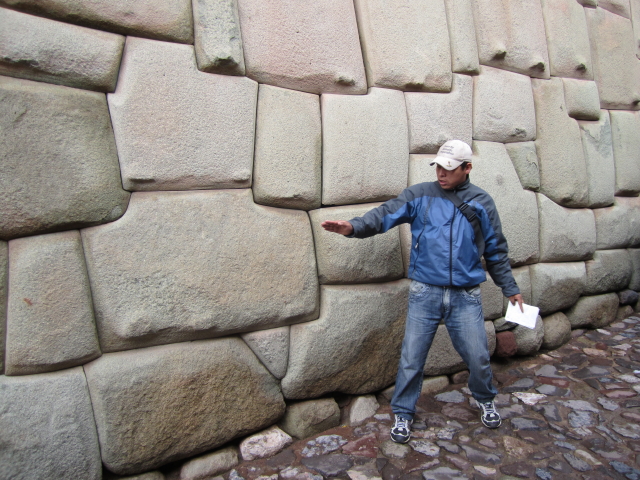
Street guide explaining how Incan's cut stone to represent animals and gods. This is a wall of what use to be an Incan palace. Oscar says there are walls from three ages: (1) Pre-incan (2) Incan (3) The Incompetents (Spanish)
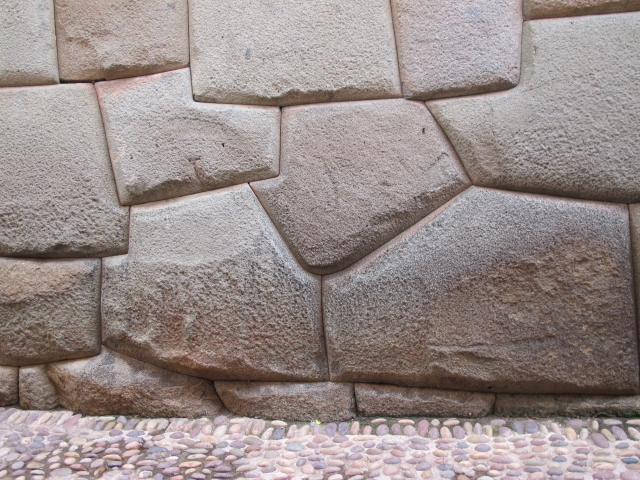
This is not fake. These stones fit together so well that not only do they not use mortar, there is absolutely no space between the stones to hold it.
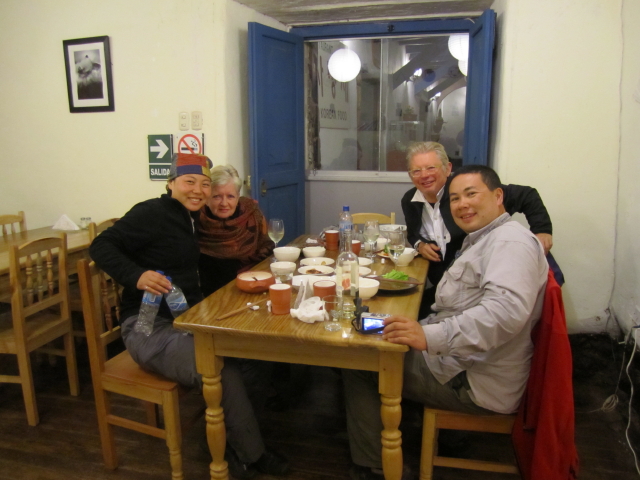
What's your definition of adventure? We met Q and Shu ("Dos Chinos") at our hotel in Cusco. They had ridden their BMW F800GS from United Arab Emirates, through the Middle East, Europe, and were now criss-crossing South America. They have been on the road for 9 months. We had a terrific dinner with them at their favorite Korean restaurant in Cusco. The next day they put their bike on a truck and drove 1000kms to Lima's BMW to get the yoke replaced.
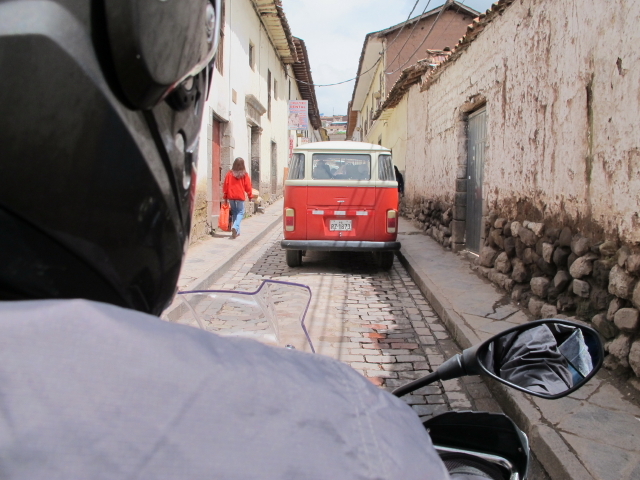 This is how we got out of Cusco — by following the nice person in this VW bus.
This is how we got out of Cusco — by following the nice person in this VW bus.
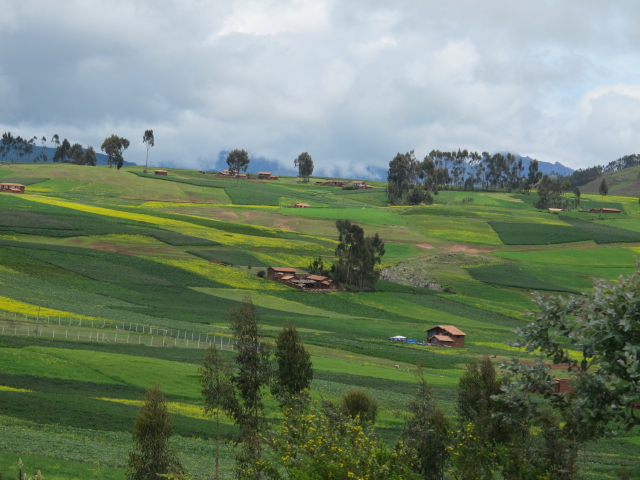
Mountains between Cusco and Ollantaytambo were alive with flowers and crops. I expected to see Julie Andrews jump out of the bushes at any minute.
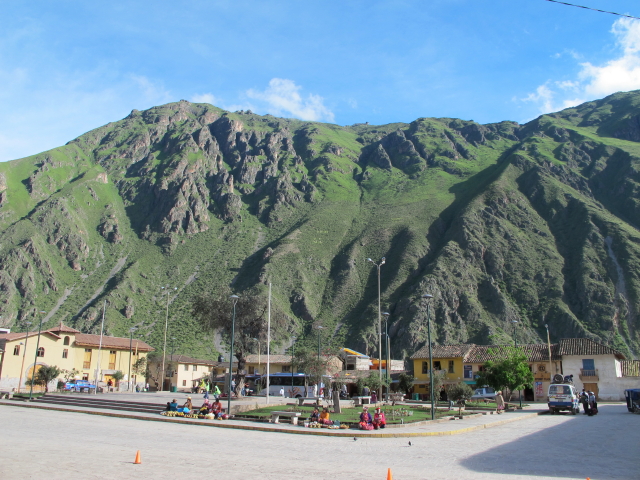
The village plaza of Ollantaytambo. The mountains that surround Ollantaytambo contain Incan ruins as well and are close enough to lure the casual trekker to take a look. Behind where this picture is taken is the Urubamba river and the train station.
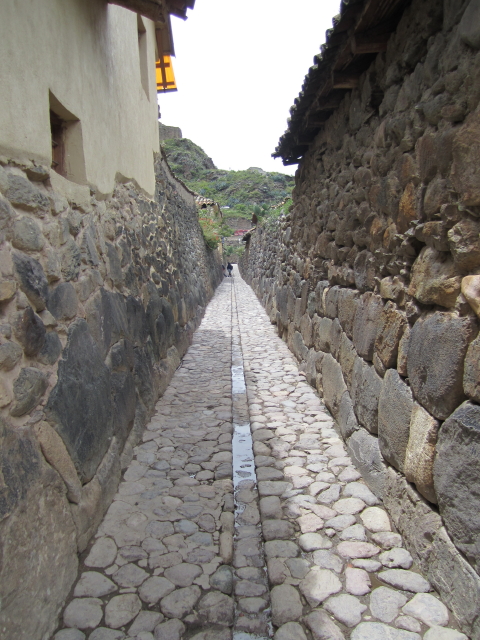
This is a typical street/walkway in Ollantaytambo. Walls are meticulously built and kept up, and everything is straight as an arrow. An irrigation stream runs down the center, part of a complex irrigation system to capture and distribute the runoff from the mountains.
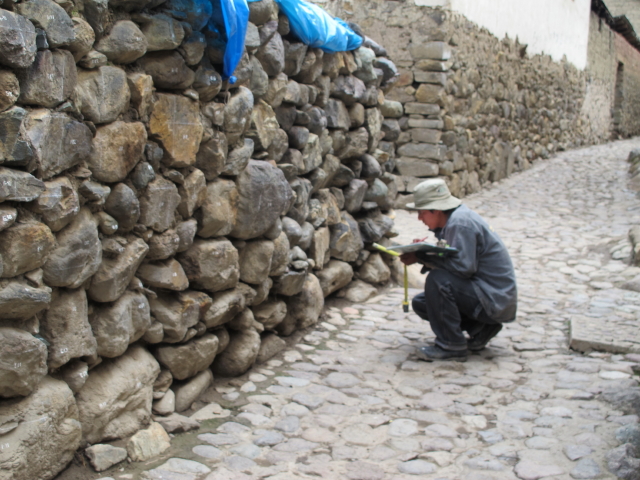
It took us a while to figure out what this guy was doing. What the photo doesn't show is the elaborately precise grid that has been drawn on the wall's stones. Each stone is also numbered alphanumerically. What was he doing? He was pushing the ancient wall (don't know how old) in order to make it perfectly straight! Couldn't quite figure out why, but it was a significant endeavor.
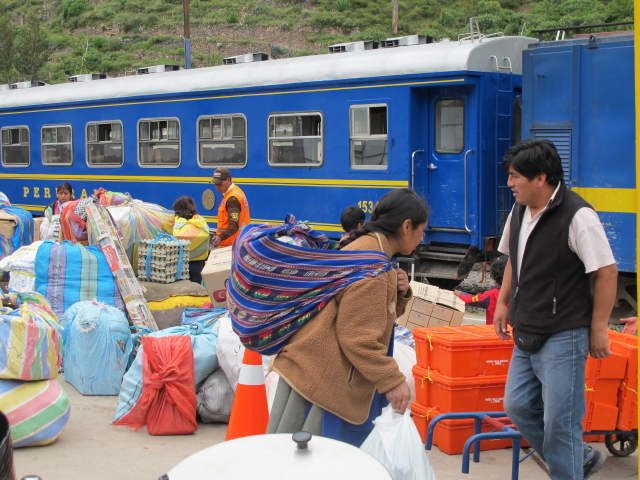
The train station is almost always busy. Here an empty passenger train has one box car in its que. Everyone on the platform is scrambling to put their various supplies in the box car. The primary method of toting stuff is wrapping them in a clothe sack called a Keperina.
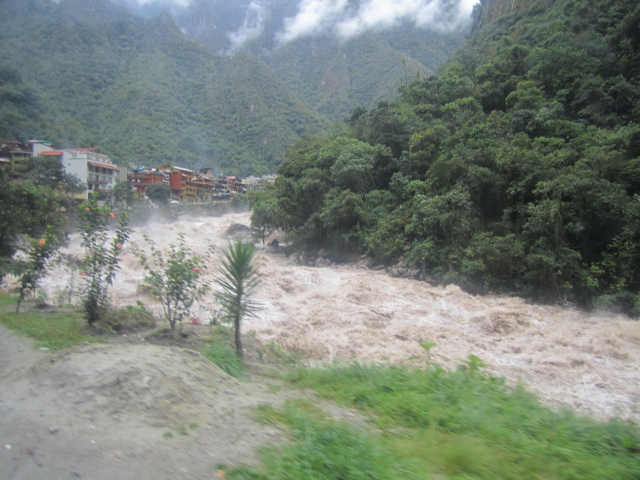
Angry river. The Urubamba River at its angriest as it careens by Aguas Calientex, at the foot of Machu Picchu.
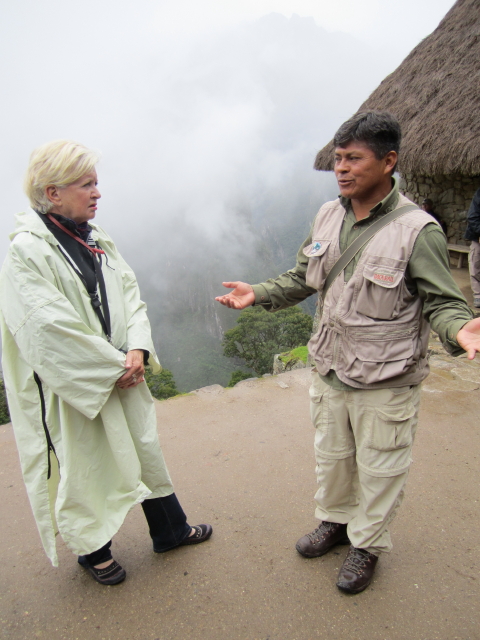
We took Jorge's advice and hired a personal guide for $50. Felix was certainly the best dressed guide we'd ever seen, looking as if he stepped out of a Columbia catalog. I didn't believe everything he said, but who's to say what the truth of Machu Picchu is?
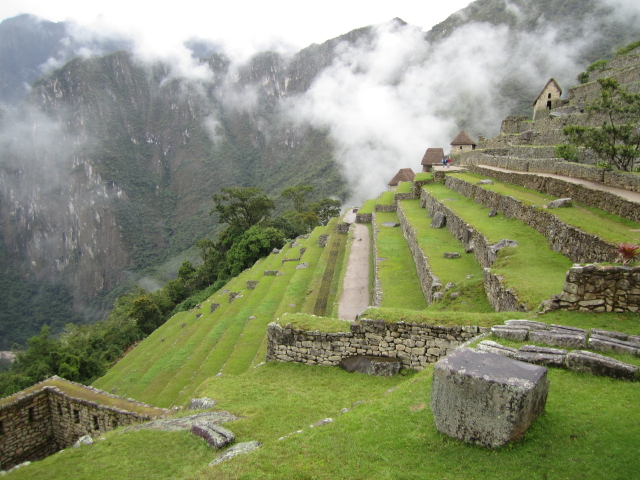
We have dozens of MP pictures that we'd like to put up. Which to cho0se? I like this one of the "agricultural section" of MP because it gives a sense of how steep everything is. Each terrace has its own irrigation channel. We're told that 90% of the stone work is original, which is stunning given that MP has probably withstood a thousand earth quakes.
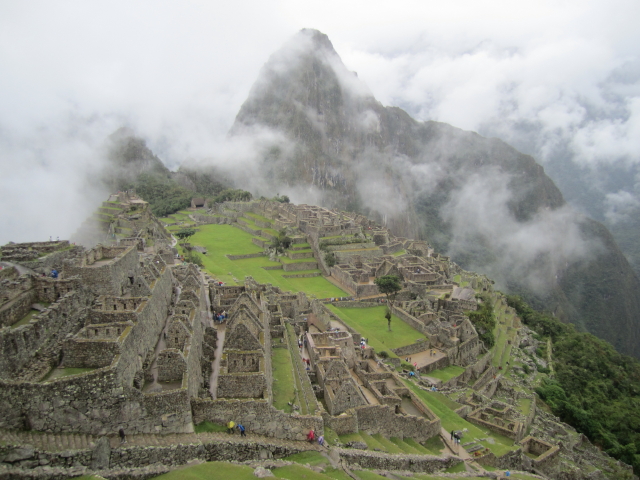
Picture taken high above the terraces in the above picture, looking down on most of MP. Down the center is the green courtyards, which might have served as military training grounds, community gathering place, and perhaps some kind of sports. Buildings to the right are commonly referred to as "worker" buildings as they are small and probably housed multiple families in each. Buildings to the upper left are for the ruling class and kings. Lots of alters, fountains, and bigger buildings.
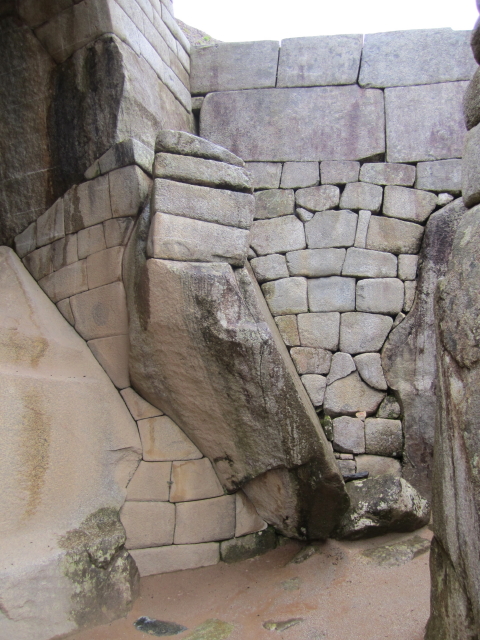
This oddly shaped wall is part of MP's most important rooms -- an elaborate alter/tomb built into a cave. It's difficult to know what large stones were left in place and built around and which were moved. This one shows precise stone work around oddly shaped large stones.
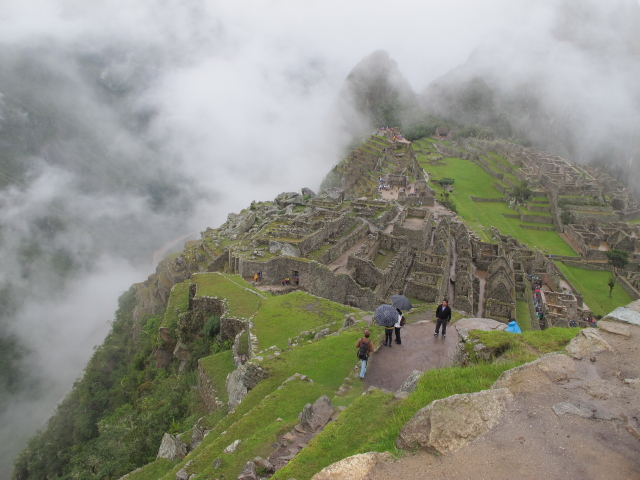
Another shot from high above, this one showing the clouds and mist rolling in. A few minutes later and none of this was visible. During our visit, a constant drizzle kept us misty. I thought it added to the experience as it made it seem both more real (this is the "normal" weather here) and more unreal -- it really did feel mystical.
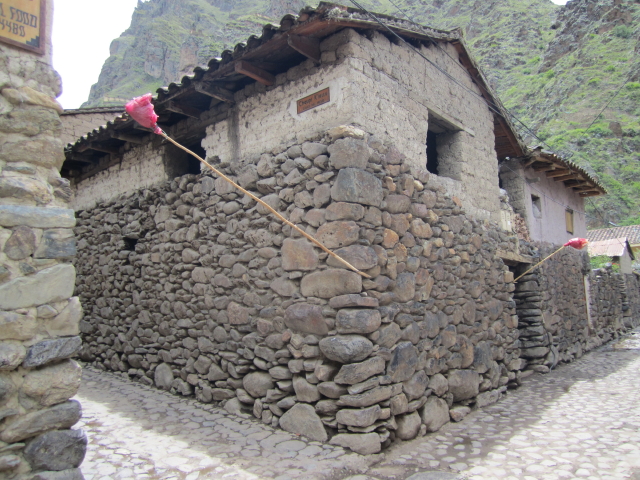
Back in Ollantaytambo, we encounter more unexplained things. This perfectly manicured old house has these two poles with red bags jutting out. KR thinks they carry herbs. The stake poles were a semi-permanent installation.
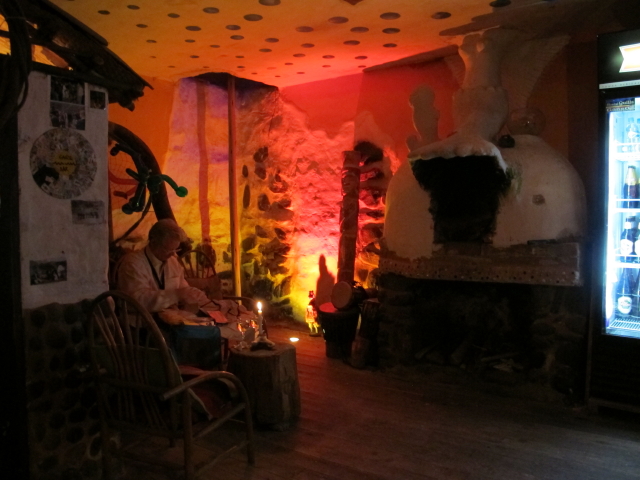
How about the coolest Reggae bar in all of Peru? Bob Marley's soul burns bright here. Pole in background is for those on the second floor can get down to the first very fast.


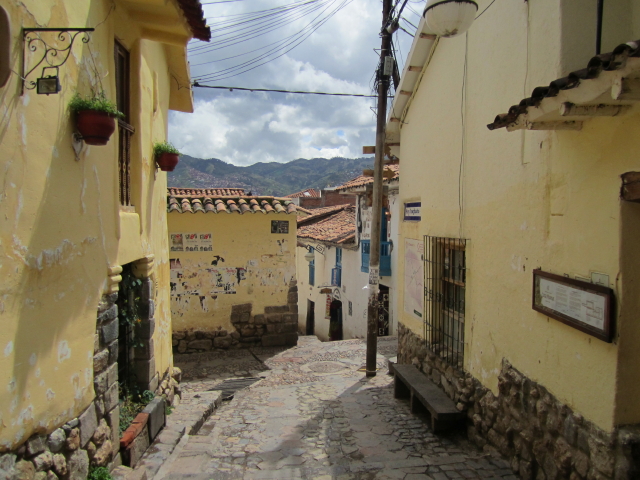


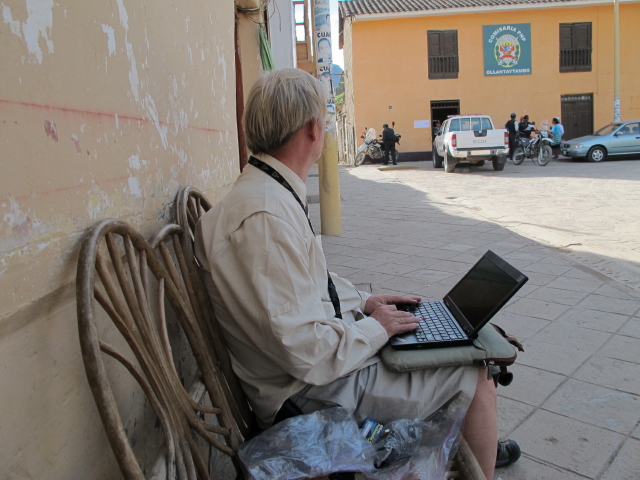
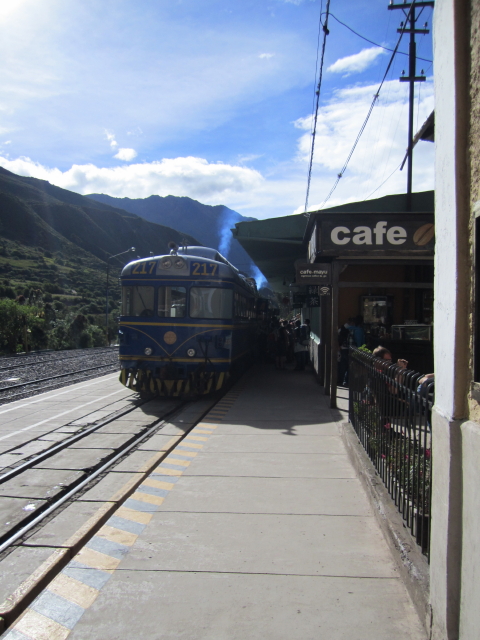
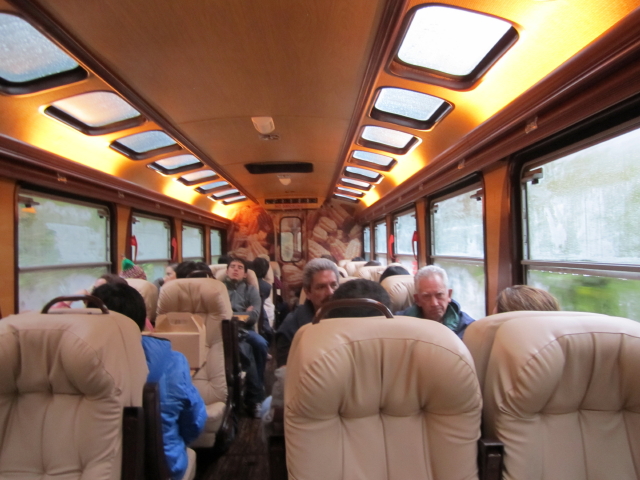
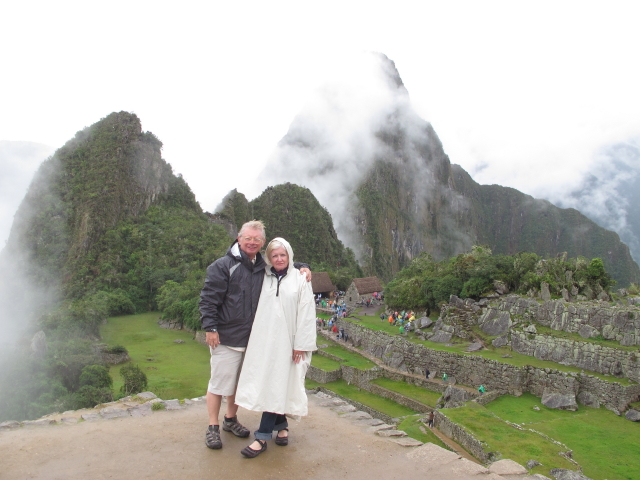
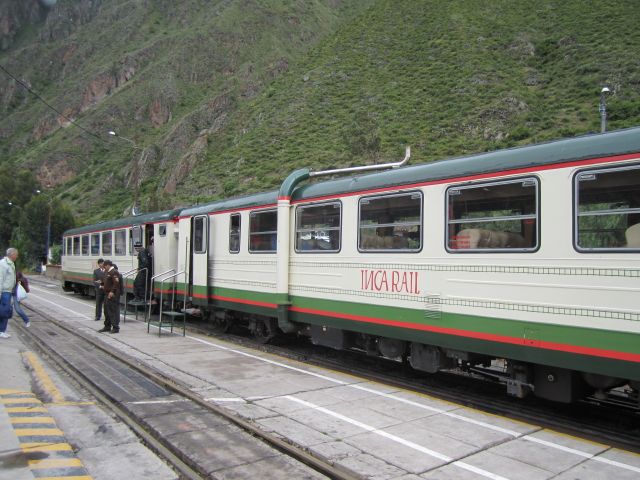
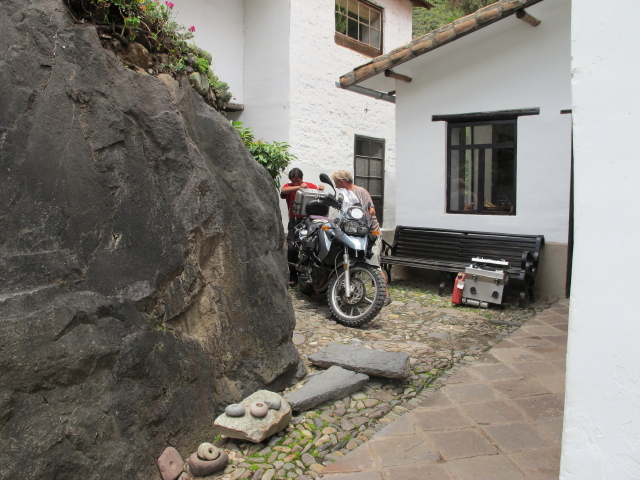
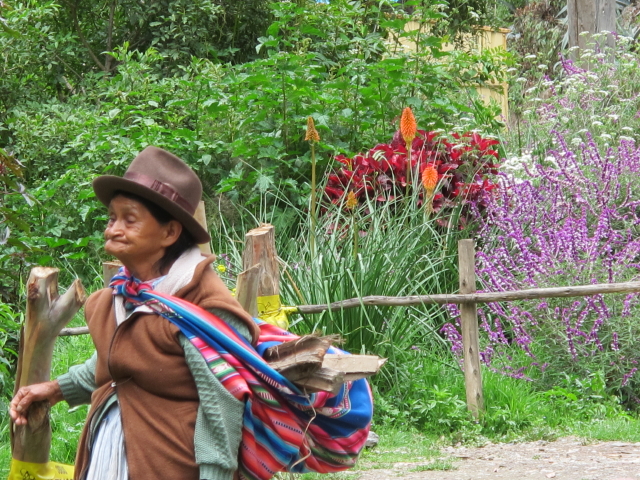
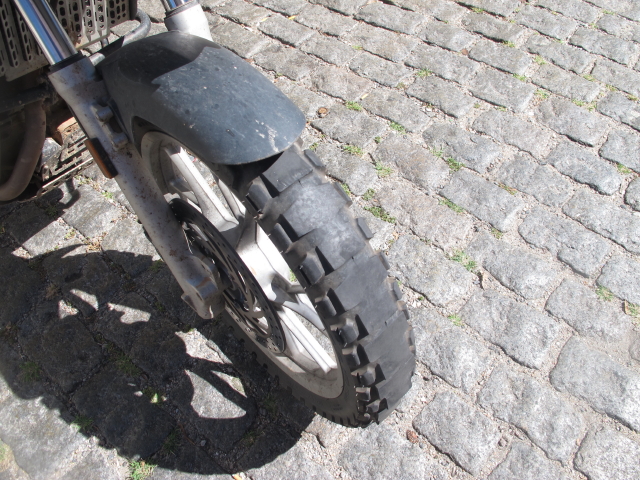
Unbelievable, magical and wonderful you two finally reached your two decade old goal. Great writing on FW’s part and beautiful photos from KRs camera. What an adventurous creative team. More, more, more
Adding to Bucket List….. #1
Great Travel Guide input for MP.
Fantastic photos and a real feeling for what you encountered on the trek.
Happy trails…
Absolutely incredible experience in photos and text. My first ever choice of destinations when I saw a picture of it as a child. I can’t wait to go. Many thanks for your informative commentary.
Hi Karen and Fred,
Thanks for the Info, MP beautiful I would love to take that trip
See you in LA